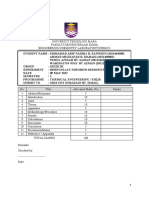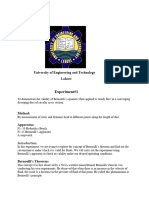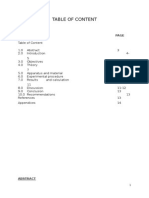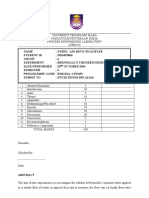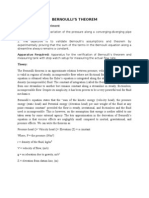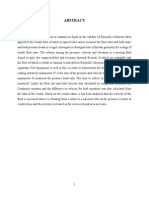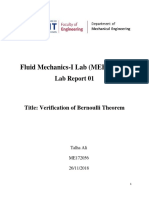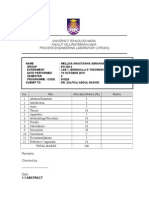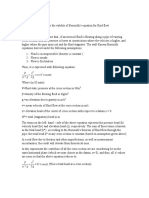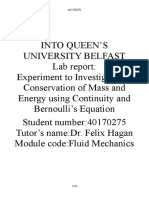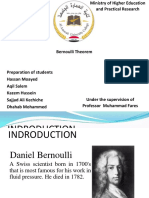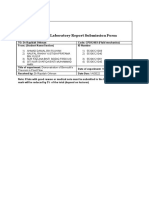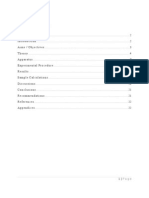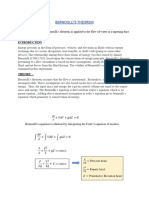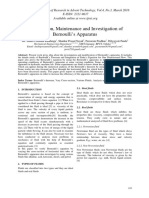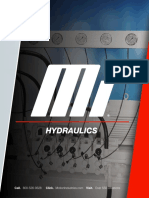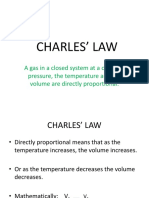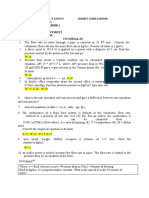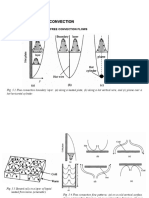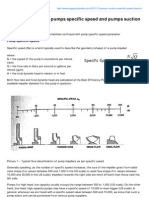Experiment No.
: 02
Name of the Experiment: Investigation of the Validity of Bernoulli’s Theorem.
1. APPARATUS:
i. Bernoulli's apparatus is used to examine the flow of water through a two dimensional perspex
convergenttdivergent passage of rectangular cross-section with piezometer tubes along its length.
ii. A constant level inlet tank to maintain a steady flow and a variable head outlet tank with a
control valve.
2. INTRODUCTION:
Energy is the ability to do work. It manifests in various forms and can change from one form to
another. The various forms of energy present in fluid flow are elevation, kinetic, pressure and
internal energies. Daniel Bernoulli in the year 1938 stated that in a steady flow system of
frictionless (or non-viscous) incompressible fluid, the sum of pressure, elevation and velocity
heads remains constant at every section, provided no energy is added to or taken out by an
external source.
This statement of Daniel Bernoulli, known as the Bernoulli's Energy Equation, can be applied
in practice for the construction of flow measuring devices such as venturimeter, flow nozzle,
orifice meter and pitot tube. Furthermore, it can be applied to the problems of flow under a sluice
gate, free liquid jet, radial flow and free vortex motion.
3. PROCEDURE
The apparatus should be accurately levelled by means of screws provided at the base. Connect
the water supply to the radial diffuser in the upstream tank. Adjust the level of the discharge pipe
by means of the stand and clamp provided to a convenient position. Allow water to flow through
the apparatus until all air has been expelled and steady flow conditions are achieved. This can be
accomplished by varying the rate of inflow into the apparatus and adjusting the level of the
discharge tube. Readings may then be taken from the piezometer tubes and the flow through the
apparatus measured. A series of readings can be taken for various through flows.
Fig.2.1 Experimental Set-up.
pg. 1
�4. WORKING FORMULA
Assuming frictionless flow, Bernoulli's Theorem states that, for a horizontal conduit
P1V2 P V2
1 2 2 (1)
2g 2g
Where, P1, P2 = pressure of flowing fluid at sections 1 and 2
= unit weight of fluid
V1, V2 = mean velocity of flow at sections 1 and 2
g = acceleration due to gravity.
The equipment can be used to demonstrate the validity of this theory after an appropriate
allowance has been made for friction losses.
5. OBJECTIVE:
1. To plot the static head, velocity head and total head against the Measuring points
in plain graph paper.
2. To plot the total head loss (hL) against the inlet kinematic head (V12/2g), for different
inflow conditions in plain graph paper.
6. ASSIGNMENT
1. What are the assumptions underlying the Bernoulli's energy equation?
2. Do you need any modification(s) of Eqn (l) when (a) the frictional head loss is to be
considered, and (b) the conduit is not horizontal?
7. DISCUSSION: Comment on the results, sources of error, etc.
Sample graph:
35
H h v2/2g
30
25
H, h, V2/2g (cm)
20
15
10
0
1 2 3 Measuring points 4 5 6
pg. 2
� Investigation of the Validity of Bernoulli’s Theorem
DATA SHEET
Table 1
Piezometer Tube No. or Measuring points 1 2 3 4 5 6
Dia. at Cross-section, cm 2.5 1.39 1.18 1.07 1.0 2.5
Cross-sectional Area, A, cm2
Velocity, V=Q/A, cm/sec
Velocity head, V2/2g, cm
Manometer reading (Pressure head), h, cm
Total Head, H=h+V2/2g, cm
Note: For discharge (Q) measurement, use either Rotameter reading (direct) such
as Q=2.19322+3.13320X, where, X=Rotameter reading, or Volume/time= Flow rate
(indirect).
Table 2
Group No. 1 2 3 4 5 6
Velocity head at Tube No. 1, V12/2g, cm
Head Loss, HL=H1-H6, cm
Name of Student :
Roll No.: Group No.:
Date : Signature of Teacher
pg. 3




